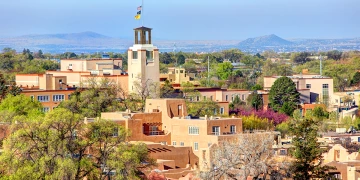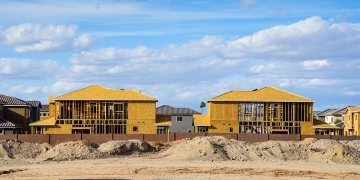Mapping Out Solutions for Urban Heat Islands
Innovative heat-mapping strategies provide insight into best design practices for urban climate resilience.

The urban heat island (UHI) effect — the tendency for concrete-and-asphalt-built cities to be hotter than surrounding rural areas — is well documented. According to the Environmental Protection Agency, the annual mean air temperature of a city with more than a million people can be 1.8 to 5.4 degrees Fahrenheit warmer than the surrounding areas, while evening temperature difference can be as much as 22 degrees F. The impact of urban heat includes increases in energy demand, air pollution and greenhouse gas emissions, heat-related illness/mortality, and water quality. Its effects have broad implications for public health and urban planning.
The phenomenon is of particular concern in the American Southwest, as it counteracts the cooling effect that otherwise occurs at night, and it has risen in importance with the increasing likelihood of extreme heat due to climate change and the continued growth of urban areas, both of which amplify the UHI effect.
Ladd Keith, Assistant Professor in Planning and Chair of the Sustainable Built Environments program at the University of Arizona’s School of Landscape Architecture and Planning, is part of a team investigating the UHI effect in a project funded by the Climate Assessment for the Southwest. The research objectives are to “document urban heat maps and their uses in cities in Arizona and New Mexico, and to develop new maps for several pilot cities interested in planning for urban heat,” says Keith. “We are also creating a learning network among the cities we are working with so that planning and design strategies to mitigate urban heat can be shared more widely.”

Urban planners at the UA documented use of urban heat maps in all cities of more than 20,000 people in Arizona and New Mexico.
Tracking a City’s Hot Spots
Heat mapping is effective in both identifying UHI areas and prioritizing cooling strategies for these locations. As part of the project, the team documented the use of urban heat maps in every city in Arizona and New Mexico with a population of more than 20,000. “While only a handful currently had urban heat maps, over half of the cities had staff that were very interested in the topic and obtaining maps in the future,” Keith says.
Existing efforts in Arizona include Tucson’s Pima Association of Governments’ urban heat map, which has informed transportation, green infrastructure and urban forestry, and neighborhood improvement; and several project-specific urban heat maps in Phoenix, developed for the city’s tree and shade master plan and improvements to its light rail system. In New Mexico, Albuquerque and Las Cruces have used urban heat maps to help guide investments in heat mitigation.
In addition to analyzing existing efforts in the Southwest, the project is providing urban heat maps to pilot cities in the region. Team member Ben McMahan is creating the maps with Landsat 8 satellite data to estimate land surface temperature and calibrating that with local meteorological observations. The pilot cities include Avondale and Buckeye, Arizona, and Santa Fe and Doña Ana County, New Mexico. Robert Busick, a planner in Buckeye, explains the city’s involvement.
“Buckeye’s interest in urban heat mapping stems from the fact that much of the city’s land area is undeveloped desert or irrigated agricultural fields that are expected to experience significant development,” Busick says. “Being part of the Phoenix metropolitan area, we are well aware of how development can exacerbate the extreme summer temperatures our region experiences.” He anticipates that heat mapping will help his planning staff in mitigating some of the UHI effect expected to occur in this fast-growing area.

UHI effect is often overlooked in terms of climate risk because its impacts aren’t as visible as other climate change factors like rising sea levels.
The Way Forward
Along with documenting current use of urban heat maps/models and working with the pilot cities to assess challenges and opportunities, the study prioritizes communication as another way of empowering communities to make better decisions. The team is in conversation with both planners and mapping staff about appropriate uses and limitations of the maps, and is sharing policy and design strategies for mitigating urban heat. The focus on collaboration suggests there is strength in numbers.
“I’m most excited about the learning network with the current and new urban heat map users,” Keith says. “Many reported wanting to be better connected to learn how other cities are using the maps to guide decisions related to urban heat.”
Extreme heat poses a special challenge. It is sometimes referred to as an invisible climate risk because its effects aren’t always as visible as threats such as sea level rise, inland flooding and wildfires. Yet what extreme heat has in common with those events, says Keith, is that certain populations are at higher risk.
“For extreme heat the most vulnerable are often the homeless, those with lower income who may not have access to air conditioning or adequate healthcare, outdoor workers, children and the elderly,” he says. “Another challenge with extreme heat is that there is no accepted governance structure for it in the U.S. Compare it with flooding, where we have standardized and accepted federal floodplain maps, local flood management departments and local land-use regulations.”
The best practices and insights yielded from the study are intended to inform communities with context- and design-specific strategies for mitigating urban heat. By equitably supporting the needs of the public, business and government, all can make gains in the quest for increased urban resilience.
